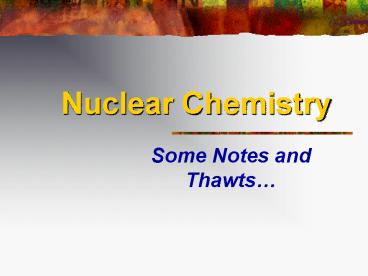Nuclear Chemistry - PowerPoint PPT Presentation
1 / 32
Title:
Nuclear Chemistry
Description:
In chemical reactions, the electrons do the work while the nucleus is idol. ... In nuclear rxns, atoms of an element change to atoms of ... Rutherford and Soddy ... – PowerPoint PPT presentation
Number of Views:30
Avg rating:3.0/5.0
Title: Nuclear Chemistry
1
Nuclear Chemistry
- Some Notes and Thawts
2
A Comparison Between Chemical and Nuclear
Reactions.
3
Where the Action Is
- In chemical reactions, the electrons do the work
while the nucleus is idol.
- In nuclear reactions, the nucleus is changed
while the orbital electrons are bystanders.
4
What Is Changed?
- In chemical rxns, substances are changed, but
atoms never change identity.
- In nuclear rxns, atoms of an element change to
atoms of another element.
5
What About Energy and Mass?
- In chemical rxns, there are small changes in
energy and no measurable changes in mass.
- In nuclear rxns, there are large changes in
energy and often large changes in mass.
6
What Affects the Reactions?
- Chemical rxns are affected by temperature,
concentration, nature of substances and catalysis.
- Nuclear rxns are only affected by number of
nuclei.
7
Definitions
8
Radioactivity
- The spontaneous disintegration or decay of an
unstable nucleus by means of emission of
radiation.
9
Nuclide
- An atom with a particular nuclear composition,
that is, a certain number of two types of
nucleonsprotons and neutrons. A nuclide is a
particular isotope.
10
The Nucleus
- The center of the atom.
- 1/10,000 of the diameter.
- One trillionth of its volume.
- Incredibly dense 1014 g/ml.
11
A Brief History
12
Henri Becquerel
- Discover that Uranium minerals emit radiation
that make bright images on photographic plates.
13
Marie Curie
- Discovered intensity of radiation is proportional
to concentration of element. - Isolated radioactive components and found new
elements, - Isolated radium.
14
Rutherford and Soddy
- Proposed that when a nuclide decays, it becomes
the nuclide of another elementthis was
outrageous at the time.
15
The Three Common Types of Radioactive Emission
16
Alpha Particles
- These are large particles Helium Nuclei.
17
Beta Particles
- Negatively charged.
- Fast electrons.
18
Gamma Rays
- Very high energy photons.
- Pure energy.
- From the excited nucleus.
19
Types of Radioactive Decay
20
Alpha (a) Decay
- Involves the loss of an alpha particle from the
nucleus. - A decreases by 4 and Z decreases by 2.
21
Beta (b) Decay
- Involves the ejection of a b particle from the
nucleus. - A stream of electrons.
- Next higher element is formed.
22
How Do Electrons Emit From the Nucleus?
- A neutron is converted into a proton and a beta
particle which is ejected/
23
Positron Decay
- Emission of positron from the nucleus.
- Antiparticle of an electron
24
Where Does It Come From?
- Proton is converted to a neutron and a positron.
- Next lower element is formed
25
Electron Capture
- Nucleus of atom draws in a surrounding electron
- From low energy level
26
What Actually happens?
- Proton in the nucleus combines with electron to
form a neutron.
27
Gamma Emission
- Pure radiation of high energy photons from an
excited nucleus. - Usually in ultraviolet or infrared light
- Gamma emissions accompany most types of decay.
28
Nuclear Stability
- N/Z Ratio
29
Neutron to Proton Ratio
- As atoms get larger, N/Z ratio increases as
neutrons increase to stabilize the strong force. - Competition between strong force and repulsive
force determines stability.
30
- Atoms with even Z have more stable nuclides.
- Nucleon pairing is similar to electron pairing.
- Unstable nuclei change N/Z to attain stability.
31
What Are the Rules?
- Few nuclides exist for N/Zlt1
- No stable nuclides for N/Z1 for Zgt20.
- All nuclides above Z83 are unstable.
32
Son of Rules
- Neutron rich nuclides hi N/Z undergo beta
decay. - Proton rich nuclides lo N/Z undergo positron
decay or electron capture. - Heavy nuclides Zgt83 undergo alpha decay.































